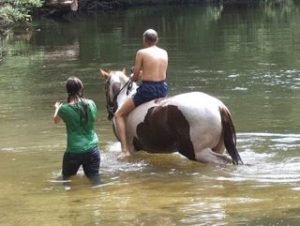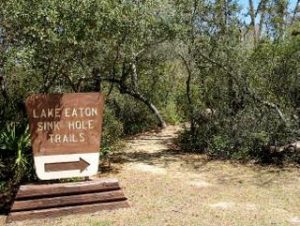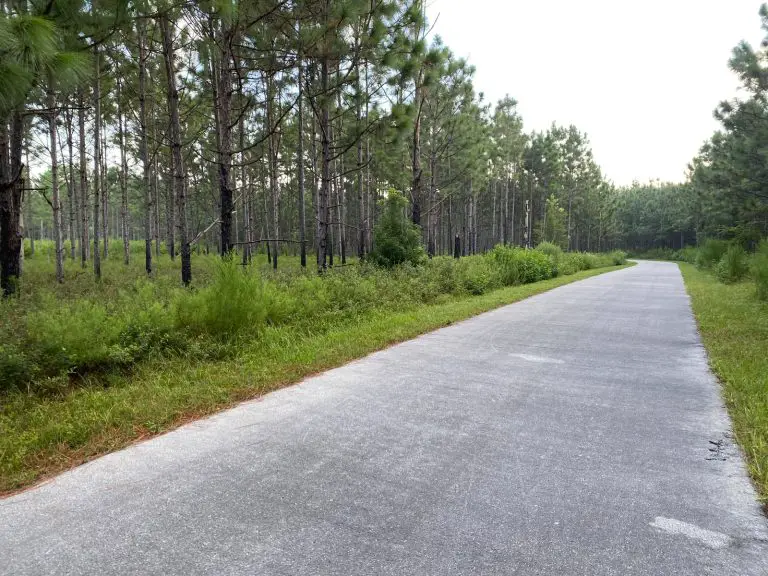Ocala National Forest is a great destination for those that long for the great outdoors. It offers a full array of activities, including camping, picnicking, fishing, hiking, horseback riding, ATVing, and many water based activities. As the southernmost US national park, the winters are quite mild, and typically dry. The long hot summers make the many different water activities very popular.
This forest of nearly 400,000 acres is located in north central Florida, between the Ocklawaha River and the St. Johns River, about 15 miles (24 km) east of the I-75 Ocala / highway 40 exit. It is divided into two ranger districts, Lake George in the north, and Seminole in the south. For those that visit the major Florida tourist attractions, the forest is about 50 miles north of Orlando. The largest sand pine forest in the world is here at Ocala.


People are surprised at how many water resources are available at Ocala National Forest. Even though it’s inland and on relatively high ground, there are over 600 lakes, streams, rivers, and springs. The springs provide very clear water for swimming, snorkeling and diving. A favorite stop for water lovers is the Alexander Springs Recreation Area, located in the south central part of the forest. This accessible area has many services including a full campground. You can even rent a canoe or kayak.

Another popular destination for snorkeling and swimming is the Silver Glen Springs Recreation Area. The clear spring water creates a cool refreshing pool about 200 feet wide. Located on the east side of the forest next to Lake George, the spring feeds into the lake, which is the largest of the St. Johns River Chain of Lakes. Lake George is the second largest freshwater lake in Florida.
Juniper Springs, located in the middle of the forest next to highway 40, is one of the oldest recreation areas on the east coast. Built in the 1930’s by the Civilian Conservation Corps, it’s also one the most well known recreation areas. There’s lots of camping, as well as picnicking, swimming, canoeing (rentals available), and hiking. A 7.5 mile (12 km) canoe trail into Juniper Prairie Wilderness is a well known Florida paddling destination. The springs, like others in the forest, are crystal clear.
With nearly 100 miles (161 km) of horse riding trails, Ocala National Forest is a must-do for equestrians, and Doe Lake Recreation Area is ideal. It has group camping facilities that include hitching posts. The 38 mile Prairie Horse Trail loop is located nearby. Go ride the Ocala 100 mile horse trail. Plan on camping overnight at some of the remote spots in the forest. Other available horse trails are the Flatwoods Trail and Baptist Lake Trail.

Ocala National Forest ATV trails are second to none in Florida. Nearly 200 miles (322 km) of ATV trails make this the off-roading place to go in the Sunshine State. But it’s not just the trails that people love. The forest has several campgrounds that really cater to the ATV community. Lake Delancy West (north central) and Big Scrub (south central) are the two areas with the best access to the OHV trail system.
The hiking in this forest is excellent. Whether you’re a day hiker or a backpacker, there are trails to suit all. Similar to Apalachicola, the Florida Trail runs through Ocala National Forest. There is almost 100 miles of this National Scenic Trail within the forest boundaries, entering from the north, southeast, and southwest. The first segment of the Florida Trail was blazed in Ocala in 1966. This trail draws the backpackers to the forest. No permit is needed for primitive camping.

St. Francis Trail is the other well known backpacking trail. It’s located on the southeast side near the St. Johns River, and is accessible from the River Forest area. The 7 mile (11.3 km) blue loop will cross several different ecosystems on the way to the ghost town of St. Francis. This short lived town was a thriving river port in the late 1800’s. The rise of the railroads was the demise of St. Francis.
There are numerous day hikes available at Ocala National Forest. Most are centered around the major recreation areas, which offer other services too. The Salt Springs Recreation Area in the northeast section of the forest (between Lake Kerr and Lake George) has a couple of short hikes. Bear Swamp Trail is a 1.5 mile (2.4 km) loop through three ecosystems: longleaf pine upland, pine flatwoods, and riverine swamp. Salt Springs Observation Trail is a 0.9 mile (1.5 km) one-way hike to a platform overlooking Salt Springs Run.

Silver Glen Springs, on the east side of the forest next to Lake George, probably has the most day hikes to offer. Yearling Trail is a one of the longer, with a 5.9 mile (9.5 km) loop that accesses the Florida Trail. There a are a number of historical points of interest along this trail, in an area that inspired the late 1930’s novel The Yearling. There is a shorter 3.9 mile (6.3 km) loop. Two other trails here are the 1.2 mile (1.9 km) Lake George Trail and the 0.2 mile (0.3 km) Boils Trail. These are one-way distances.
If you’re on the southeast side of Ocala National Forest, Clearwater Lake Trail is a 1.3 mile (2.1 km) loop through longleaf pine upland. There’s a trailhead for Florida Trail next to the area entrance. In the south central part of the forest is Alexander Springs and the 1.1 mile (1.8 km) Timucuan Trail loop. This trail traverses a riverine swamp ecosystem and leads you past two observation platforms overlooking Alexander Springs Creek.

The Lake Eaton area towards the west side of the forest has two trails. The Lake Eaton Loop Trail is a 2 mile (3.2 km) hike through sand pine scrub and swamp. The other trail is the Lake Eaton Sinkhole Trail. The attraction on this 1.8 mile (2.9 km) loop is of course, the sinkhole. There are stairs leading down into this dry sinkhole. There’s a 0.4 mile (.6 km) trail directly to the sinkhole.
There are many other trails available to you in Ocala National Forest. The three visitor centers are ideal places to pick up park information. The Ocklawaha Visitor Center is located in the west as you approach the forest on highway 40, the Cross Florida Greenway. This is a nice area to sit and relax, or take a little hike on the Silver River Trail, which would be a 3 mile (4.8 km) round trip. The center is normally open from 9AM to 5PM daily.

The other two visitor centers have irregular hours, so call ahead. Salt Springs Visitor Center (phone 352-685-3070) is located on highway 19 in the northern section of the forest. Pittman Visitor Center (phone 352-669-7495) is located on highway 19 on the south side of the forest.
There is one other extremely unique feature of Ocala National Forest. There’s a US Naval Bombing Range right in the middle of the forest. The controversial Pinecastle Bombing Range has been actively used by the Navy for over 50 years. You’ll be glad to know that this area of over 5000 acres is fenced off and closed to the public.
A trip to central Florida really should include some time for a trip northward to Ocala National Forest. The ecosystems of sand pine scrub and longleaf pine are some fine examples of what Florida used to look like. The springs, a key component of the Floridan aquifer system, produce crystal clear pools for great water activities. Year round, this is a wonderful place for getting back to nature.

